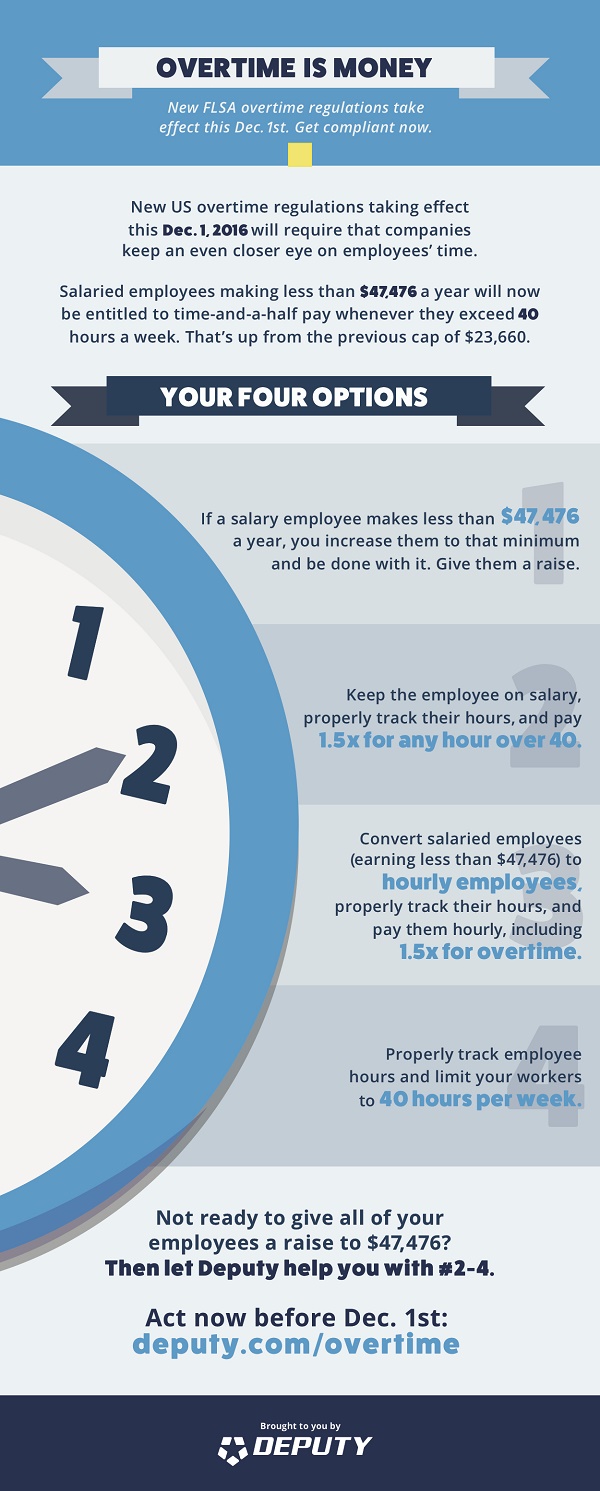Avoid Talking to the Department of Labor with Workforce Management Technology
By Jason Walker
The U.S. Department of Labor (DOL) shook up employers across the country when it announced its updated regulations for overtime compensation, taking effect on December 1, 2016. Under the regulation, any employee—even full-time, exempt salaried employees that fall within the executive, administrative and professional categories—will be eligible for time-and-a-half pay whenever they surpass 40 working hours in a week.
While overtime is usually a human resources (HR) concern, research indicates that most businesses with less than 50 employees either outsource or use HR software services. According to the U.S. Census there are approximately 4.4 million small-to medium-sized businesses with less than 20 employees. Therefore, it stands to reason that a large majority of 4.4M businesses in the US do not know about the overtime regulation because they do not have an HR department or professional, and are not prepared for it.
The reality is that 4.2 million Americans make less than the new $47,476 threshold. This means thousands of SMB employers now have less than 100 days to understand how the law impacts them as well as take action to maintain compliance. If they do not take action they risk having a conversation with the Department of Labor down the line – something nobody wants.
So how can employers avoid speaking with the Department of Labor? Essentially, there are four ways to comply:
In order for employers to decide the proper plan of action for their business the best thing to do is be proactive and follow auditing tips including:
- Reviewing the business’ overall compensation structure to see who is affected by the change and determine whether or not it is affordable to make employees exempt under the new salary threshold.
- Begin tracking employee time to ensure compliance with general labor laws for all hourly and salaried employees earning less than the threshold.
- Educating staff members on why time tracking will be more closely monitored.
- Adjusting responsibilities for employees so work can be completed during a 40-hour work week, if overtime is too costly.
- Evaluating cost efficiency between hiring part-time workers or replacing the positions that qualify for overtime pay.
- Reviewing existing time tracking systems and making upgrades, if necessary.
Even with these tips, ensuring a smooth transition to regulations can still be daunting. Luckily, workforce management technology is offering small businesses an all-in-one solution that help provide protection and guidance to comply with government regulations while also helping enhance team communication, task management, performance management and more. Here are some ways that workforce management technology can create a seamless transition and provide protection:
- Better recordkeeping. Software and digital time sheets make tracking and archiving employee hours easy and accurate. Some technologies even offer GPS and facial detection options to track hours, which help avoid any discrepancies – like when employees clock in for one another.
- Anticipated sales and traffic help determine shifts. Workforce management technology makes anticipated costs versus sales analytics available to managers in advance of making scheduling decisions. This allows schedules to be more stable and reduces companies’ reliance on overtime hours.
- Over-scheduling is prevented with stress profile alerts. Solutions with built-in stress alerts can notify managers when employees are scheduled for too many hours, days or consecutive shifts in a given week. This not only helps managers monitor the workforce morale, but can also signal when non-exempt employees are close to reaching the 40-hour, time-and-a-half benchmark.
- Employees are empowered. Retention is an issue at most companies today. Workforce management technology encourages employees to manage their schedules, while employers manage changes based on costs and overtime forecasts. In response, a more empowered workforce yields less turnover and lower onboarding costs for businesses.
With less than 100 days, the countdown to overtime is officially on. Ultimately, workforce management technology helps ensure that companies will be prepared for the December 1 deadline by providing the compliance protection they need and standard business practices-made-efficient, helping small- to medium-size businesses across the country save time, money and establishing peace of mind.
Jason Walker is a thought leader within the SaaS and retail industries and has worked with some of the biggest brands you know, including Home Depot, HP, Best Buy, Target, Apple, and Nokia. Jason currently serves as President, Americas of Deputy, a leading global workforce management solution.








